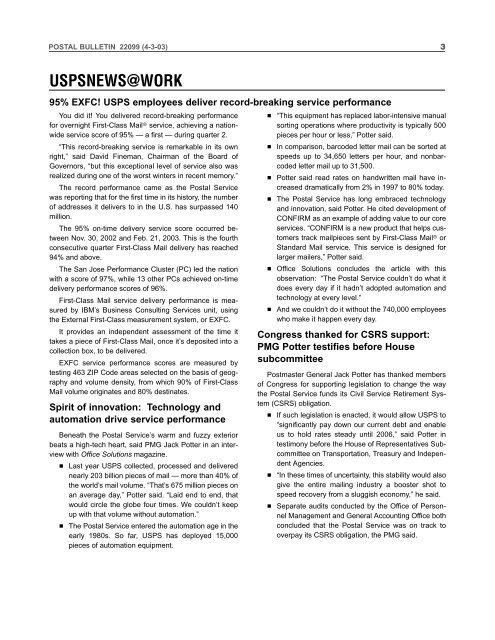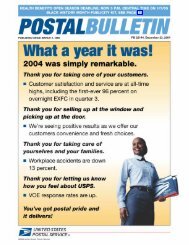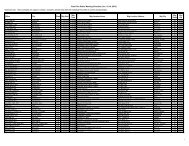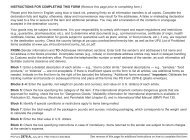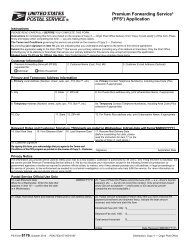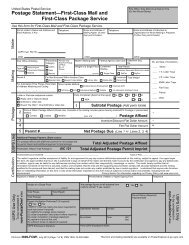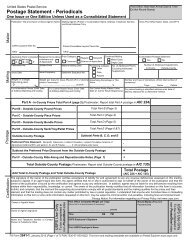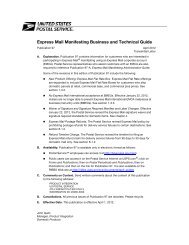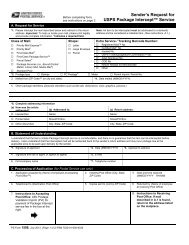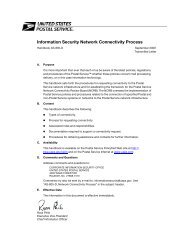Postal Bulletin 22099 - April 3, 2003 - USPS.com
Postal Bulletin 22099 - April 3, 2003 - USPS.com
Postal Bulletin 22099 - April 3, 2003 - USPS.com
Create successful ePaper yourself
Turn your PDF publications into a flip-book with our unique Google optimized e-Paper software.
POSTAL BULLETIN <strong>22099</strong> (4-3-03)<br />
3<br />
<strong>USPS</strong>NEWS@WORK<br />
95% EXFC! <strong>USPS</strong> employees deliver record-breaking service performance<br />
You did it! You delivered record-breaking performance<br />
for overnight First-Class Mail service, achieving a nationwide<br />
service score of 95% — a first — during quarter 2.<br />
“This record-breaking service is remarkable in its own<br />
right,” said David Fineman, Chairman of the Board of<br />
Governors, “but this exceptional level of service also was<br />
realized during one of the worst winters in recent memory.”<br />
The record performance came as the <strong>Postal</strong> Service<br />
was reporting that for the first time in its history, the number<br />
of addresses it delivers to in the U.S. has surpassed 140<br />
million.<br />
The 95% on-time delivery service score occurred between<br />
Nov. 30, 2002 and Feb. 21, <strong>2003</strong>. This is the fourth<br />
consecutive quarter First-Class Mail delivery has reached<br />
94% and above.<br />
The San Jose Performance Cluster (PC) led the nation<br />
with a score of 97%, while 13 other PCs achieved on-time<br />
delivery performance scores of 96%.<br />
First-Class Mail service delivery performance is measured<br />
by IBM’s Business Consulting Services unit, using<br />
the External First-Class measurement system, or EXFC.<br />
It provides an independent assessment of the time it<br />
takes a piece of First-Class Mail, once it’s deposited into a<br />
collection box, to be delivered.<br />
EXFC service performance scores are measured by<br />
testing 463 ZIP Code areas selected on the basis of geography<br />
and volume density, from which 90% of First-Class<br />
Mail volume originates and 80% destinates.<br />
Spirit of innovation: Technology and<br />
automation drive service performance<br />
Beneath the <strong>Postal</strong> Service’s warm and fuzzy exterior<br />
beats a high-tech heart, said PMG Jack Potter in an interview<br />
with Office Solutions magazine.<br />
Last year <strong>USPS</strong> collected, processed and delivered<br />
nearly 203 billion pieces of mail — more than 40% of<br />
the world’s mail volume. “That’s 675 million pieces on<br />
an average day,” Potter said. “Laid end to end, that<br />
would circle the globe four times. We couldn’t keep<br />
up with that volume without automation.”<br />
The <strong>Postal</strong> Service entered the automation age in the<br />
early 1980s. So far, <strong>USPS</strong> has deployed 15,000<br />
pieces of automation equipment.<br />
“This equipment has replaced labor-intensive manual<br />
sorting operations where productivity is typically 500<br />
pieces per hour or less,” Potter said.<br />
In <strong>com</strong>parison, barcoded letter mail can be sorted at<br />
speeds up to 34,650 letters per hour, and nonbarcoded<br />
letter mail up to 31,500.<br />
Potter said read rates on handwritten mail have increased<br />
dramatically from 2% in 1997 to 80% today.<br />
The <strong>Postal</strong> Service has long embraced technology<br />
and innovation, said Potter. He cited development of<br />
CONFIRM as an example of adding value to our core<br />
services. “CONFIRM is a new product that helps customers<br />
track mailpieces sent by First-Class Mail or<br />
Standard Mail service. This service is designed for<br />
larger mailers,” Potter said.<br />
Office Solutions concludes the article with this<br />
observation: “The <strong>Postal</strong> Service couldn’t do what it<br />
does every day if it hadn’t adopted automation and<br />
technology at every level.”<br />
And we couldn’t do it without the 740,000 employees<br />
who make it happen every day.<br />
Congress thanked for CSRS support:<br />
PMG Potter testifies before House<br />
sub<strong>com</strong>mittee<br />
Postmaster General Jack Potter has thanked members<br />
of Congress for supporting legislation to change the way<br />
the <strong>Postal</strong> Service funds its Civil Service Retirement System<br />
(CSRS) obligation.<br />
If such legislation is enacted, it would allow <strong>USPS</strong> to<br />
“significantly pay down our current debt and enable<br />
us to hold rates steady until 2006,” said Potter in<br />
testimony before the House of Representatives Sub<strong>com</strong>mittee<br />
on Transportation, Treasury and Independent<br />
Agencies.<br />
“In these times of uncertainty, this stability would also<br />
give the entire mailing industry a booster shot to<br />
speed recovery from a sluggish economy,” he said.<br />
Separate audits conducted by the Office of Personnel<br />
Management and General Accounting Office both<br />
concluded that the <strong>Postal</strong> Service was on track to<br />
overpay its CSRS obligation, the PMG said.


